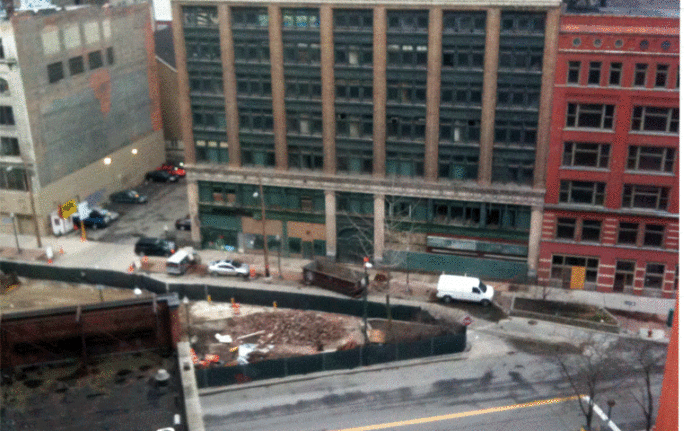Frenetic Urbanism
 For a few days last week, the small urban triangle known as Capitol Park and the surrounding area was radically transformed for the filming of Transformers 3. Piles of rubble, explosions, robots, and a new streetscape were installed as part of director Michael Bay’s elaborate set. This sort of temporary urbanism is becoming more and more common as the Michigan film incentive draws site scouts to the area. In upcoming films, Detroit will be portraying Paris, the Soviet Union, Switzerland, Baltimore, Washington, D.C. and many other U.S. cities. In recent months residents have witnessed rallies by the ‘Peoples’ Liberation Army’, dramatic life of a retired CIA operative, even stumbled upon a rogue NYC subway station at the Guardian Building. While it is exciting to experience the instant gratification of these fleeting installations, we should not to overlook the slow but lasting progress occurring in urban spaces like Capitol Park.
For a few days last week, the small urban triangle known as Capitol Park and the surrounding area was radically transformed for the filming of Transformers 3. Piles of rubble, explosions, robots, and a new streetscape were installed as part of director Michael Bay’s elaborate set. This sort of temporary urbanism is becoming more and more common as the Michigan film incentive draws site scouts to the area. In upcoming films, Detroit will be portraying Paris, the Soviet Union, Switzerland, Baltimore, Washington, D.C. and many other U.S. cities. In recent months residents have witnessed rallies by the ‘Peoples’ Liberation Army’, dramatic life of a retired CIA operative, even stumbled upon a rogue NYC subway station at the Guardian Building. While it is exciting to experience the instant gratification of these fleeting installations, we should not to overlook the slow but lasting progress occurring in urban spaces like Capitol Park.
The Capitol Park Improvement Project, which calls for new paving, landscaping, lighting, and signage, has been underway since last year and is nearing completion. The park is bordered by Griswold, Shelby, and State streets and held the first State Capitol Building in 1837 when Michigan gained statehood. The site functioned as a transit hub from 1955 until the recent completion of the Rosa Parks Transit Center. Now the Downtown Detroit Partnership and the city of Detroit’s Downtown Development Authority have joined with the design firm Merz & Associates to return the park to a public greenspace.
Watching the simultaneous development of fast and slow urban interventions in Capitol Park, one wonders if its possible to coordinate the enormous investment involved in the staging of movie sets to lasting urban benefit. How can the creative freedom and imagination that go into these filmic vignettes be incorporated into planning models and similarly how can urban development projects partner with film crews to more permanently enhance the environments they engage?




